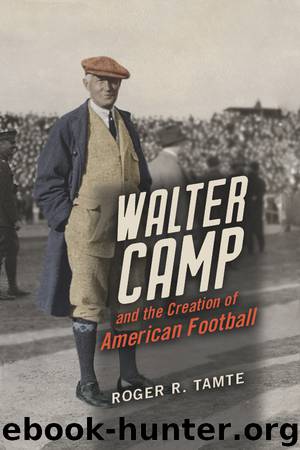Walter Camp and the Creation of American Football by Roger R Tamte

Author:Roger R Tamte
Language: eng
Format: epub
Publisher: University of Illinois Press
Pax Intercollegiata
36
Diplomat, politician, friend—any and all might apply to Walter Camp in the summer of 1895, as he reached out to Harvard's W. A. Brooks at the same time he struggled to overcome disruptions Brooks had caused in football rule making. Brooks, the accuser of Yale's Hinkey! The man Camp's Yale friends refused to meet.
“Billy” Brooks and Camp had been friends for several years, exchanging letters at least by 1890 and working together both on the IFA's Graduate Advisory Committee and on the UAC's rules committee. Camp was surely involved in the selection of Brooks to referee every Princeton-Yale game since 1887.
Camp got a productive correspondence under way in the summer of 1895, apparently by requesting photos from Brooks to illustrate a book or article. Brooks sent the photos, and Camp wrote a gracious note of thanks.
Brooks then responded with a letter that unburdened some of his feelings. How much he wished that Harvard and Yale men could let bygones be bygones, could get together and make a fresh start, saying nothing about “what had been.” “That ‘darn’ letter”—his published letter accusing Hinkey—“is the one thing I regret in my athletic career.” While insisting that everything in the letter was true, he recognized that subsequent events had gotten out of hand, suggesting that sometimes a perceived wrong must be overlooked for a larger good.1
Brooks and Camp had made peace, were still friends despite the storm that engulfed Harvard and Yale. But their resumed friendship was overlaid with a practical political fact: Brooks was still a leader in Harvard football. A relationship with Brooks might help Camp reestablish relations with Harvard as a whole, might nudge Harvard into cooperating on football rules and athletic management.
“We cannot go through another season” like last year, the secretary of the new Southern Intercollegiate Athletic Association wrote Caspar Whitney in January 1896. The previous year, rules for each game had to be compromised from the two different sets published in Spalding's Official Football Guide. The SIAA secretary told Whitney their association would appoint its own committee to prepare its own playing rules.2
Alonzo Stagg wrote Camp similarly, asking whether the eastern factions “will come together for one set” of rules. “If not, we in the west will probably come up with our own list.”3
Different sets of football playing rules, here and there around the country, would be intolerable. Football would lose its central identity and appeal, with different games developing around different sets of rules. Negotiations would be required each time a team of one rule set wanted to play a team of a different rule set; sometimes there would be no agreement and no game.
But there was still hope. The secretary of the SIAA finished his letter to Whitney by promising that, if the two factions, Harvard-Pennsylvania-Cornell and Princeton-Yale, would “get together before next season and make a uniform set we will agree to adopt that.” Stagg's note to Camp said the same.
Whatever part Camp's diplomacy may have played, this year the UAC was ready to help with rule making.
Download
This site does not store any files on its server. We only index and link to content provided by other sites. Please contact the content providers to delete copyright contents if any and email us, we'll remove relevant links or contents immediately.
| Baseball | Basketball |
| Boxing, Wrestling & MMA | Football |
| Golf | Hockey |
| Soccer |
Imperfect by Sanjay Manjrekar(5806)
Wiseguy by Nicholas Pileggi(5675)
The Body: A Guide for Occupants by Bill Bryson(4978)
Tuesdays with Morrie by Mitch Albom(4696)
Unstoppable by Maria Sharapova(3486)
Not a Diet Book by James Smith(3342)
Crazy Is My Superpower by A.J. Mendez Brooks(3336)
Into Thin Air by Jon Krakauer(3316)
The Mamba Mentality by Kobe Bryant(3190)
The Fight by Norman Mailer(2849)
Finding Gobi by Dion Leonard(2785)
Tuesdays With Morrie by Mitch Albom(2698)
The Ogre by Doug Scott(2635)
My Turn by Johan Cruyff(2579)
Unstoppable: My Life So Far by Maria Sharapova(2457)
Accepted by Pat Patterson(2310)
Everest the Cruel Way by Joe Tasker(2281)
Borders by unknow(2232)
The Quarterback Whisperer by Bruce Arians(2221)
